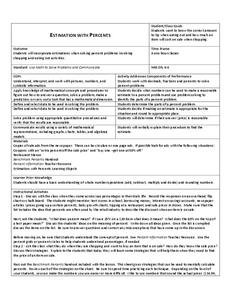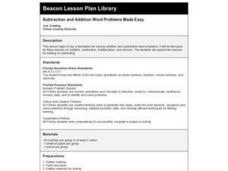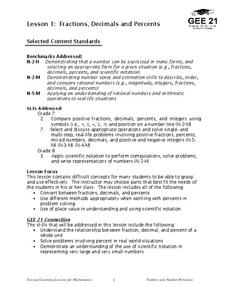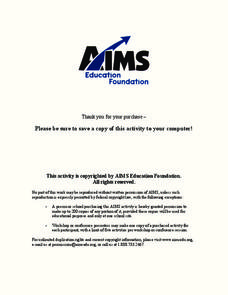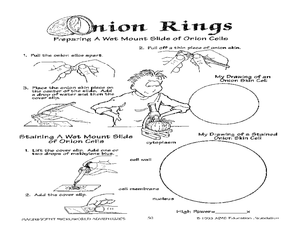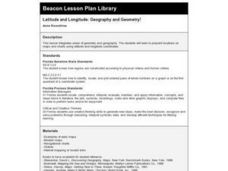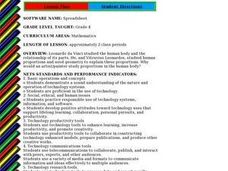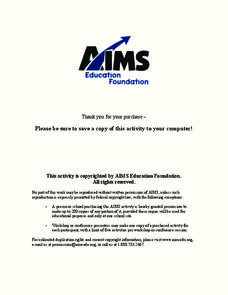Curated OER
Understanding Radios
Fifth graders explore ratios. Using models and real-world scenarios, they complete tables and generate comparisons. Pupils demonstrate multiple ways of writing ratios and describe the differences between ratios.
Curated OER
Estimation With Percents
Students examine percents. In this percents instructional activity, students will estimate percentages. Using advertisements from a newspaper, students problem solve to determine the final price of a sale item.
Curated OER
Subtraction and Addition Word Problems Made Easy
Third graders create addition and subtraction word problems for a partner to solve using marbles. They explain whether the problem is an addition, subtraction, "take away", "have and need", compare or "what is the rest" type problem.
Curated OER
Great Tasting Shapes
Fifth graders investigate the concept of median, mode, and range using a simple model for display purposes. They examine different shaped crackers out of a box and identify the ones that occur the most. Then the calculations for the...
Curated OER
Using Inequalities to Problem Solve
Learners explore inequalities. In this Algebra I lesson, students solve and graph linear inequalities involving addition, subtraction, multiplication, or division. Learners use inequalities to solve and graph real-world problems.
Curated OER
Sum of the Parts
Fifth graders build objects using various materials. They estimate the weight of the object using individual building pieces. Then they weigh the actual object and then tear it apart and weigh the pieces. They compare the two weights.
Curated OER
Leaping Lemurs! How far can you jump?
Learners watch a segment of the PBS video which show the lemurs' ability to jump. In pairs, students collect measurement data involving each other's length of a standard step, a standing broad jump, and a long jump. They record their...
Curated OER
Function Tables
Students practice representing problems found in the real world in terms that can be translated into mathematical expressions. The situations are represented in tables and graphs by students.
Curated OER
Fractions, Decimals, and Percents
Learners connect different mathematical concepts. They create a circle graph. Students then create a question in which they collect data in order to convert fractions to decimals and decimals to percents.
Curated OER
Balanced Or Unbalanced
Students use physical models and graphs in order to solve problems that have their origin in the real world that require algebraic thinking. The words are changed into equations and inequalities in order to be solved. This requires...
Curated OER
By Golly, By Gum
Students investigate the ingredients and creation of chewing gum. In this scientific method lesson, students make predictions about what will happen to the mass of a piece of gum as it is chewed by a human. Students graph the...
Curated OER
Watt Power
Students discuss the concept of power and the meaning of watts. For this experimental lesson students divide into groups, record data and calculate the results.
Curated OER
Terrific Tessellations
Students explore tessellations that are found in nature and everyday objects. They observe the works of M.C. Escher. Students create their own tessellations using pencil and paper.
Curated OER
Onion Cells
Students observe the cells of an onion by wet mounting it and viewing it in a microscope. In this hands on lesson plan students make their own wet mount slide of an onion and are able to identify the cells in it such as, the...
Curated OER
The Quadratic Formula
Students solve quadratic function by completing the square. In this algebra lesson plan, students use the quadratic formula to factor quadratics and find the roots. They graph the parabola and identify its properties.
Curated OER
Latitude and Longitude: Geography and Geometry!
Second graders use latitude and longitude coordinates to pinpoint an exact location on the map. In this geography lesson, 2nd graders utilize handouts from the Maritime Museum in order to gain practice in finding locations throughout the...
Curated OER
Body Proportion
Fourth graders measure the height and arm span of various classmates. They use a spreadsheet to design a graph that shows the class measurements from tallest to shortest in metric and standard systems.
Curated OER
Linear Patterns in Data
Eighth graders extend their learning of graphing linear equations and are introduced to connecting patterns in tables and graphs to represent algebraic representations. They then determine patterns and extrapolate information from these...
Curated OER
Chance (Probability) Operations in Dance Composition -
Eighth graders investigate modern-dance choreographer Merce Cunningham's historically significant contribution to dance-making history. Specifically, 8th graders explore and practice Merce Cunningham's choreographic use of chance...
Curated OER
Weighing stations
Students work at a variety of stations involving practical measuring tasks. Estimation skills and the ability to measure accurately using kilograms and grams are developed.
Curated OER
Cool Times with Heat
Learners work with thermometers to complete problems about temperature. They investigate cooling patterns, how location affects temperature, and what happens when water having different temperature is mixed. They measure temperature in...
Curated OER
Learning to Measure
Fourth graders explore measuring with English unit rulers. They practice measuring in fractions of inches. Students discuss how to place the ruler when measuring an object. They begin measuring using rulers with 1/4 inch increments and...
Curated OER
Measuring Body Parts
Young scholars engage in a lesson to measure body parts. They use the measuring tape to record the data of body measurements. Students must choose the appropriate unit of measurement and compare the data for the different parts of the...
Curated OER
Blow and Go
Students discover how air can move things by using their breath. In this physics lesson plan, students hypothesize then attempt to move a pencil 1 meter using nothing but their breath. Students record data from their experiment including...

